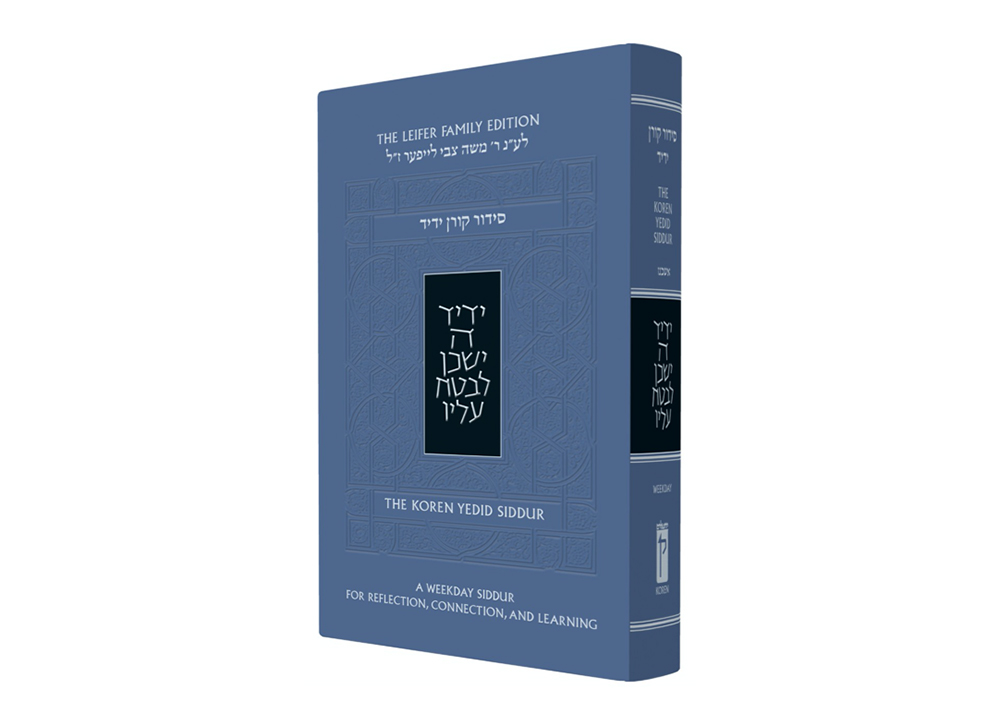
Reviewing: “Koren Yedid Siddur” Koren Publishers. Translation by Rabbi Lord Jonathan Sacks; Developed by Binyamin Casper.
Hebrew/English. Hardcover. 760 pages.
A newly released siddur by Koren Publishers Jerusalem that uses an innovative color-coding method to draw attention to the deeper meaning of the prayers has its roots in Bergen County. The visionary of this siddur, Binyamin Casper, grew up in Teaneck and graduated from Yavneh Academy and Ramaz High School before making aliyah to Modi’in in 2016. During the pandemic, Casper spent many hours exploring ways he could bring more meaning to his praying and began marking up his siddur and categorizing the prayers according to three essential categories that comprise the liturgy. He self-published a Mincha—Maariv siddur based on this methodology and soon after pitched his project to Koren Publishers. Working with Casper, the Jerusalem publisher developed this technique into a full siddur, known as The Koren Yedid Weekday Siddur, which is set to be available for public sale in late summer.
At the heart of the siddur lies the belief that the essence of prayer is a conversation that takes place with a beloved one—God—or a “yedid” in Hebrew. It is through this lens that Casper hopes “to ignite the romance of tefillah,” as he explains in his own words. By classifying words and phrases, he aims to draw the worshiper’s attention to the key concepts of the siddur by focusing on the individual parts that make up the whole, resulting in greater emotion and thought in prayer and more heartfelt dialogue with God. The siddur is highlighted in both the Hebrew text and Rabbi Lord Jonathan Sacks’ English translation in blue for words that reflect the category “attributes and actions of God,” in orange for words that reflect the category “requests of God,” and in green for words that reflect the category of “our essence and aspirations.”
The category “attributes and actions of God” reflects descriptions of God and his actions that we strive to learn and emulate. “Requests of God” are words and phrases that evoke our personal supplications, and “our essence and aspirations” are the values we seek to uphold and embody as we fulfill God’s will.
Notably absent from the siddur is any commentary that would draw the worshiper’s eyes away from the prayers, as the color-coding in itself is a form of commentary integrated directly into the text. Casper and the Koren Publishers team were very intentional about setting strict guidelines for the color-coding process in order to avoid overwhelming any sentence with excess color and to refrain from assigning colors to text that is outside the realm of single categories, such as quotes from the five books of Torah.
The siddur opens with three haskamot from esteemed rabbinic leaders in the United States and Israel, Rabbi Moshe Weinberger of Woodmere, Rav Yosef Zvi Rimon of Gush Ezion and Rabbi Efrem Goldberg of Boca Raton. The siddur also includes a “how-to” section that explains the meaning behind the three categories and offers guidance on how to use the siddur as a tool to enhance one’s prayer.
Casper spent one year combing through every line of text in Hebrew and English and working alongside the team at Koren Publishers and his rabbinical consultant Rabbi David Silverstein to produce this unique siddur. He calls the tedious process “a labor of love” that enhanced his professional life as a venture capitalist.
“It’s so sad to go through life three times a day every day and not appreciate the beauty of what we are saying,” Casper said. He quoted Rav Kook who used to say that our soul is praying all day long, and that it is only during formal prayer that we give our soul a voice. “I am aspiring to give those words more of a voice through this method,” Casper said.
Casper envisions The Koren Yedid Siddur to serve not only as a vehicle for more authentic prayer and connection with God but to also be used as a teaching tool for educators. He is currently developing a curriculum for schools, and a few dozen copies of the siddur have already been shared with educational institutions so that administrators and teachers can begin planning over the summer how to integrate this teaching tool into the classroom to enhance their students’ journey with prayer.
Director of Education at Koren Publishers Rabbi Dr. Daniel Rose added, “Koren is committed to finding new and innovative ways to approach tefilla, through a diverse series of educational siddurim to achieve these goals. The Koren Yedid Siddur is the latest creative contribution to the market in this realm, allowing individuals, students and teachers to take a new approach to reflecting on the text of the siddur and use the siddur to form new and stronger ways to connect and develop a relationship with God.”
The siddur is dedicated to the late grandfather of Casper’s wife, Rabbi Moshe Tzvi Leifer z”l, whom Casper calls “a larger than life personality.” Rabbi Leifer, better known to Casper as his Zaidy, gave him confidence in all areas of his life and also inspired his religious growth. “It’s very special that it bears his name,” Casper said. “I think about how much joy he would get from seeing this.”
Alisa Bodner is a Fair Lawn native who immigrated to Israel over a decade ago. She is a nonprofit management professional who enjoys writing in her free time.









